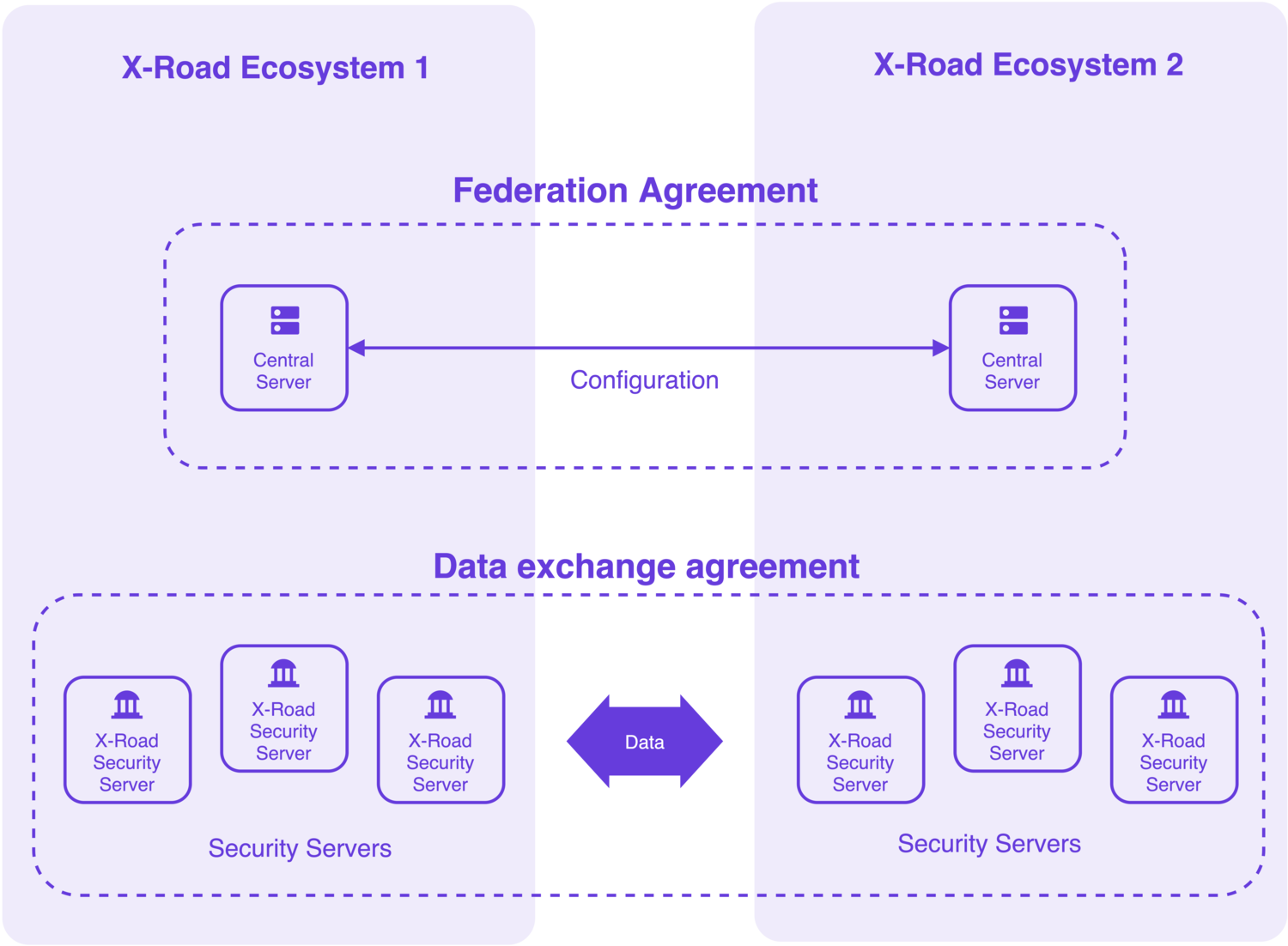The challenges that X-Road® addressed in Estonia in 2001 included the lack of private networks – which resulted in developing secure data exchange over the public Internet – and connectivity (between databases) rather than data availability and discovery for the cross-use of data, including operational data of the ecosystem.
The operational data generated in over twenty X-Road environments worldwide is gradually emerging as a significant digital asset and should be better utilised for creating insights and optimal decisions, enhancing the processes and, thereby, the product.
In the future, X-Road as a connected ecosystem of ecosystems could get System of Systems (SoS) characteristics, which require thinking beyond questions usually associated with engineering. In this blog post, we’ll get food for thought about what the data-enabled future of X-Road could look like.
X-Road as it is now
X-Road® is open-source software and ecosystem solution that provides unified and secure data exchange between organisations. It allows service providers to make themselves visible in services directed at citizens, businesses, and civil servants. Creating data products that combine different services and data sources is easy and cost-efficient.
X-Road Ecosystem
According to the X-Road Product Vision 2024:
X-Road is a modular, easy-to-adopt, easy-to-use, cloud-native, secure and sustainable data exchange solution.
X-Road is thriving as a core digital infrastructure component in the Nordic and EU countries and is a worldwide known technology solution.
From a "technical magic bullet" to a source of innovation?
X-Road software has been in production use since 2001 in Estonia. The original challenges that X-Road addressed included the lack of private networks – which resulted in developing X-Road for secure data exchange over the public Internet – and connectivity (between databases) rather than data availability and discovery for the cross-use of data, including operational data of the ecosystem. What we today identify as ecosystem benefits were just consequences of database connectivity at that time.
The operational data generated in over twenty X-Road environments worldwide is gradually emerging as a significant digital asset and stealing the stage from programming languages, frameworks, libraries and other technologies that were seen as primary focus areas when X-Road was born twenty years ago. There is a constant shift from a "technical magic bullet" to a data-enabled source of innovation.
X-Road Ecosystems
The X-Road ecosystems (instances) worldwide are operated by governments, companies or other organisations. The ecosystems are not technically connected with each other because each ecosystem is independent with its rules and regulations, allowing operating it securely and according to the respective country's legislation.
Although X-Road ecosystems are independent technical and administrational instances, since 2014 (version 6.x), X-Road has a feature called Trust Federation for joining together two X-Road ecosystems.
Members of the federated ecosystems can publish and consume services with each other as if they were members of the same ecosystem. In practice, the members can use the same Security Server for national and cross-border data exchange.
It is possible to create federation connections with multiple X-Road ecosystems, but transitive federation relationships are not supported. An ecosystem does not have a federation relationship with another ecosystem not directly federated with.
Also, the federation is not only about technology since administrative and legal agreements are also needed between X-Road operators of the federated ecosystems and organisations that exchange data (data exchange parties).
X-Road Trust Federation
The ecosystem model and the Trust Federation feature have been developed to facilitate secure data exchange, excluding the innovative use of real-time data about the ecosystem and its processes.
So far, the deployments of X-Road worldwide have been relatively independent, and NIIS as the software developer has no role or visibility in those ecosystems. There is no built-in developer access to the ecosystems, and no data is sent to NIIS, even for statistical purposes.
Data collection model based on the Metrics component
Besides the X-Road core and trust service components, its ecosystem has additional modules that support the operations and use of the ecosystem. These building blocks provide member management and onboarding capabilities, service discovery, metrics collection and reporting, and technical monitoring.
X-Road has a tool called X-Road Metrics for collecting, storing and analysing reporting data and metrics from an X-Road ecosystem, but currently, the operational data of an X-Road ecosystem is not shared with others by default. This is at least partly a consequence of the thinking at the time when the data-centric approach to ecosystems and platforms had not risen yet.
The metrics include service usage statistics, response times, request sizes, service health data, etc. The metrics can measure the ecosystem's size and activity and provide exciting information about the relationships between different member organisations and their services.
The information enables the X-Road operator to overview the ecosystem's state and measure its growth. To get an overview of the whole ecosystem, the raw metrics must first be read from all Security Servers and then stored and analysed centrally.
X-Road Metrics
The real-time data in X-Road operation could be better utilised for creating insights and optimal decisions, enhancing the processes and, thereby, the product.
To illustrate the data value, NIIS has already developed separate calculators for assessing the costs and CO2 emissions of an X-Road ecosystem. Still, those could be developed further to utilise real-time data and allow comparing with other ecosystems to enhance the performance.
The X-Road Ecosystem Threshold for Growth
Kristjan Vassil back in 2016 analysed the fiscal impacts of X-Road in the context of Estonia and their X-Road environment X-tee. For that, he acquired relevant time-variant data on X-Road usage in Estonia.
Vassil started with the question of how many services were offered in X-Road by how many institutions. Finally, Vassil observed the number of data repositories that different organisations connected to the X-Road ecosystem in Estonia. The data repositories are the critical building blocks for final products (digital services and applications).
Vassil suggests that building an effective digital government will take time and hinge on the number of separate databases that organisations can incorporate into a system like the X-Road, upon which institutions can subsequently start building their end products for users. The discrete threshold for growth appears at 50 data repositories.
The discovery of the threshold of 50 data repositories illustrates the birth of a true ecosystem when using the X-Road software in a context similar to Estonia (a governmental deployment with similar characteristics). Therefore, most likely, the ecosystem benefits resulting in operational data that can be collected also start gathering at an equivalent threshold.
The System of Systems characteristics of X-Road ecosystems
Several software products have mechanisms for collecting usage data, thus helping improve the product. But this is not the case with a critical data infrastructure building block.
X-Road, with its operational data distributed worldwide at its user organisation, has System of Systems (SoS) characteristics, which require thinking beyond questions usually associated with engineering to include socio-technical and sometimes socio-economic phenomena.
NIIS should address these complexity factors to enable the collection and sharing of operational data between different ecosystems and their member organisations. The ownership of data in X-Road always belongs to the organisation sharing it within the ecosystem. But the ownership of the operational data is at the discretion of the operator organisation – typically a digital agency of a country.
X-Road is also at the crossroads of different digital ecosystems. The services might be available in diverse ecosystems, platforms and domains. In X-Road, a uniform ecosystem provides a significant source of operational data representing the society as a whole (to a certain extent, depending on the ecosystem).
Steps toward data-enabled X-Road
The first steps toward data-enabled X-Road should include developing the X-Road Metrics component as an enabler of data sharing between the ecosystems. This might require System of Systems Engineering to resolve potential challenges.
The application of diverse technologies to enable data exchange shouldn’t anymore be the primary source for the X-Road product strategy. The concept of X-Road has evolved since the end of the 1990s, and the technologies are subject to change time by time.
Instead, the future roadmap and digital strategy could be based on data utilisation and ecosystem value creation enabled by the X-Road concept. The current ecosystems worldwide are large enough to produce valuable data about the usage to be shared with every organisation involved.
Developing X-Road metrics further would allow innovative use of data between all user organisations worldwide with the following characteristics:
parallel data sharing separated from the secure data exchange
an incentive for data sharing – share data and get data
collection of
service and usage data
configuration data
performance data
sustainability data
innovative and data-enabled product development.
First, all the X-Road ecosystems should deploy X-Road Metrics and start collecting the data from their Security Servers. Then, the data from various X-Road Metrics instances could be transferred via the Open Data API of X-Road Metrics to a data lake and then a data warehouse.
Alternatively, other tools besides X-Road Metrics could be used for the data collection on the ecosystem level as long as they implement the Open Data API specification.
Once the process for collecting X-Road usage data is fully implemented, NIIS could start defining the X-Road product strategy from an entirely new starting point.
Ville Sirviö is the CEO of NIIS. He welcomes everyone to discuss the future of X-Road in the X-Road Community.




